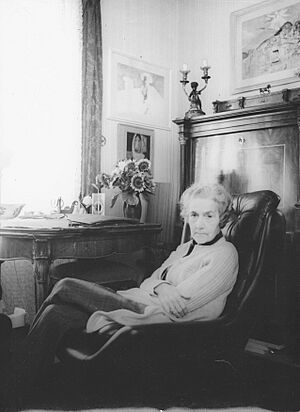Ester Šimerová-Martinčeková facts for kids
Ester Šimerová-Martinčeková (born January 24, 1909 – died August 7, 2005) was a famous Slovak artist. She was known for her paintings, her designs for theater sets, and her work as a journalist. Her art often changed to reflect the world around her.
Contents
Early Life and Art School
Ester Fridriková was born in Bratislava on January 24, 1909. Her mother was a musician who faced challenges because she was a woman. This made her want to support Ester's dream of becoming an artist.
Ester went to art schools in Paris, France, during the years between the two World Wars. She studied at the Académie Julian and the Académie Moderne. A big influence on her art was her teacher, Aleksandra Ekster. Ekster taught her a style called Cubo-Futurism, which mixes sharp shapes and movement.
Her Artistic Journey
Ester Šimerová-Martinčeková's artworks were often affected by big political changes. This happened throughout her career, from her early studies in the 1920s to her last paintings in the 1990s.
In the 1930s, her Modern paintings were seen as brave and new. However, when the Nazis came to power, they called her art "degenerate art" and did not like it.
After World War II, Ester moved from Bratislava. The topics in her art began to change. Her early Modern works became popular again in the 1960s. Around this time, she also started trying out collage, which is art made by gluing different materials together. One theme that she often painted was chess.
Later Years and Views
Šimerová was known for her thoughts on how art and politics connect. In 1934, she said that modern art is mostly about being artistic. She believed that social ideas could be shown better through things like film, radio, and theater.
Even 30 years later, in 1966, she still felt that modern art relied too much on politics. However, in her later works, she often included symbols like workers and doves of peace. These symbols clearly showed political ideas.
Ester was married twice. After her first marriage, she was known as Ester Fridriková-Šimerová. Her first husband, František Šimer, was a doctor who helped people resist the Nazis. He was arrested in 1942 and later died.
After her second marriage, she became Ester Šimerová-Martinčeková. Her second husband, Martin Martinček, was a lawyer and politician. He was removed from his public job after the 1948 coup.
From the late 1940s, Ester Šimerová-Martinčeková lived in Liptovský Mikuláš. Her health started to get worse in the 1990s. She created her very last artwork in 1994. Ester Šimerová-Martinčeková passed away in Liptovský Mikuláš in 2005.
Awards and Recognition
Šimerová received important awards for her art. In 1991, she was given the Order of Tomáš Garrigue Masaryk, 4th class. This award was presented by President Václav Havel.
In 2001, she received the Order of Ľudovít Štúr, 1st class. This award was given to her by President Rudolf Schuster.
Her Lasting Impact
Šimerová's Cubist artworks are a very important part of Slovak art history. She is often called the "first lady of Slovak painting" because of her influence.
Her art has even appeared on stamps. In 1987, the Czechoslovak post office put her painting Tulips on a stamp. In 2016, Slovenská pošta chose her "Chess composition" artwork for another stamp.
A book about her life and art was published in 2014 by L̕udmila Peterajová. It includes many pictures of her artworks and tells her life story.
Images for kids




